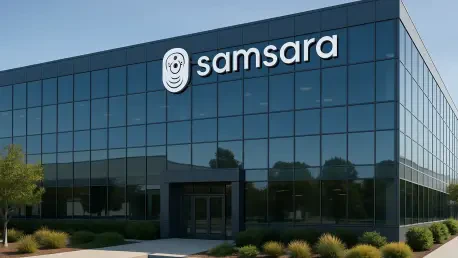Samsara Inc. (NYSE: IOT) has carved out a formidable presence in the Industrial Internet of Things (IoT) and Software-as-a-Service (SaaS) arenas, turning heads with an exceptional performance in the second quarter of fiscal year 2025. With revenue soaring 30% year-over-year to $391.5 million and annual recurring revenue (ARR) reaching $1.64 billion, the company is demonstrating significant strength in a crowded market. This remarkable growth, coupled with innovative technology and strategic positioning, raises a critical question: can Samsara sustain this momentum to become a dominant force in industrial IoT? The answer lies in dissecting its financial achievements, technological advancements, market opportunities, and the challenges that could shape its trajectory. By examining these facets, a clearer picture emerges of whether Samsara is poised to lead or if hurdles might impede its ascent in this rapidly evolving sector.
Financial Strength and Scalability
Robust Q2 Performance Metrics
Samsara’s financial results for Q2 2025 paint a picture of resilience and strategic acumen, even as economic uncertainties loom large. A 30% year-over-year revenue spike to $391.5 million underscores the company’s ability to capture market share while navigating headwinds like inflation. Beyond top-line growth, the non-GAAP gross margin climbed to an impressive 78%, reflecting efficient cost management and a scalable business model. The operating margin also saw a significant boost, rising to 15%, up 9 percentage points from the prior year. This margin expansion, paired with a 71.4% earnings per share beat at $0.12, signals that profitability is keeping pace with growth. Additionally, generating $44.2 million in adjusted free cash flow highlights a cash-generative operation, providing the flexibility to reinvest in innovation. These metrics collectively demonstrate a company not just riding a wave of demand but building a foundation for sustained financial health in a competitive landscape.
Equally telling is the structure of Samsara’s revenue, with 98% derived from recurring subscriptions, a hallmark of predictability in the SaaS space. This subscription-based model ensures a steady cash inflow, mitigating the volatility often associated with one-time sales. Such stability is a magnet for investors seeking reliable returns amid market fluctuations. Furthermore, the ARR milestone of $1.64 billion, also up 30% year-over-year, points to strong customer commitment and recurring value. This financial discipline is particularly notable given broader economic challenges, as it shows Samsara’s ability to prioritize long-term scalability over short-term gains. The balance between aggressive expansion and profitability sets a high bar, positioning the company as a standout in the industrial IoT sector. For stakeholders, these numbers are more than just figures; they reflect a deliberate strategy to build a durable, growth-oriented enterprise capable of weathering external pressures.
Sustaining Growth through Discipline
Delving deeper into Samsara’s financial strategy reveals a meticulous approach to balancing growth with fiscal responsibility. Unlike many high-growth tech firms that prioritize expansion at the expense of margins, Samsara has managed to enhance profitability without curbing its ambitious targets. The focus on recurring revenue not only stabilizes income streams but also fosters a customer-centric model where long-term value trumps short-term wins. This is evident in how the company reinvests cash flow into research and development, ensuring its offerings remain cutting-edge while maintaining healthy margins. Such discipline is crucial in a sector where innovation cycles are rapid and customer expectations are ever-evolving. By achieving this equilibrium, Samsara demonstrates maturity beyond its years, appealing to investors who value both growth potential and financial prudence in equal measure.
Moreover, the company’s ability to generate substantial free cash flow provides a buffer against macroeconomic turbulence, such as rising costs or supply chain disruptions. This liquidity allows for strategic moves, whether through acquisitions, partnerships, or internal innovation, without the burden of excessive debt. It also underscores a business model designed for scalability, where operational efficiencies translate directly into bottom-line gains. The emphasis on non-GAAP metrics like a 78% gross margin further illustrates a commitment to operational excellence, ensuring that growth doesn’t come at the cost of profitability. For a company operating in the dynamic industrial IoT space, this financial fortitude is a competitive edge, enabling Samsara to outpace rivals who may struggle with similar economic constraints. This disciplined approach could well be the linchpin in maintaining its upward trajectory over the coming years.
Technological Edge and Market Opportunities
Driving Efficiency through AI Innovation
At the core of Samsara’s appeal lies its pioneering use of artificial intelligence (AI) to revolutionize operational efficiency across industries like transportation and logistics. Harnessing a massive dataset—comprising 20 trillion annual data points, 90 billion miles traveled, and 300 million digitized workflows—the company’s AI-driven tools are redefining how businesses address safety and productivity. Features such as AI Multicam, commercial navigation, and asset maintenance solutions deliver actionable insights that translate into real-world benefits. A striking example is Maxim Crane, which saved $13 million in downtime costs through predictive maintenance enabled by Samsara’s platform. This kind of tangible impact is a key driver behind the company’s high customer retention rates, particularly among large enterprises, with a 94% retention rate for clients using multiple products. Such loyalty reflects the indispensable nature of these innovations in daily operations.
Beyond individual success stories, Samsara’s technological prowess is fueling broader adoption among enterprise clients, with those generating over $1 million in ARR now accounting for more than 20% of total ARR. The number of customers with ARR exceeding $100,000 has also surged by 30.7% to 2,771, signaling deep penetration into high-value accounts. This growth isn’t merely a numbers game; it highlights how AI is solving critical pain points like labor shortages and cost overruns, issues that plague industrial sectors globally. By embedding AI into its IoT solutions, Samsara offers a differentiated value proposition that competitors struggle to match. The continuous refinement of these tools, powered by ever-growing data inputs, creates a virtuous cycle of improvement, ensuring that clients remain engaged and dependent on the platform for their operational needs. This technological edge positions Samsara as a frontrunner in transforming industrial workflows.
Capitalizing on Expanding Market Dynamics
Samsara’s growth is further amplified by favorable market trends that align seamlessly with its strategic focus on digital transformation. Stabilizing interest rates and a 32.4% year-over-year increase in SaaS deal values in 2024, driven by private equity interest, create a conducive environment for investment and expansion. The global push for automation, spurred by labor shortages and supply chain disruptions, dovetails with Samsara’s AI-driven solutions, making them increasingly relevant across diverse sectors. Moreover, the total addressable market (TAM) is on a steep upward trajectory, projected to grow from $137 billion in the current year to $200 billion by 2026. This expansion is fueled by cross-industry demand for digital tools that enhance safety, sustainability, and cost efficiency, areas where Samsara excels. The company’s relevance in logistics and retail, bolstered by a global SaaS-based supply chain management market growing at a 12.5% CAGR through 2034, underscores its timely market fit.
Emerging markets present another layer of opportunity, with regions like Japan offering significant potential despite historically low SaaS adoption. Supported by government initiatives, these markets could become major growth drivers, adding to Samsara’s global footprint. However, tapping into such regions requires navigating cultural and regulatory nuances, a challenge the company must address to fully capitalize on this $200 billion TAM. Closer to home, industrial sectors in established markets continue to prioritize connected operations, further expanding the demand for Samsara’s offerings. The alignment of these macro trends with the company’s core competencies creates a robust growth runway, provided execution remains sharp. As digital transformation becomes non-negotiable for businesses worldwide, Samsara stands to benefit immensely from being at the forefront of this shift, provided it can adapt to varying market needs with agility.
Strategic Alliances and Challenges
Partnerships Fueling Industry Penetration
Samsara’s strategic collaborations with original equipment manufacturers (OEMs) such as Hyundai Translead and Rivian are pivotal in extending its reach into critical industries like transportation and construction. These partnerships do more than diversify revenue streams; they enhance the quality of data feeding into Samsara’s AI models by providing real-time operational insights. This creates a feedback loop where better data drives better solutions, ultimately increasing customer value and platform stickiness. Such alliances are instrumental in penetrating niche markets where specialized needs dominate, allowing Samsara to tailor its offerings to specific industry pain points. The result is a broader ecosystem that not only strengthens market presence but also fortifies the company’s competitive moat against rivals who lack similar integrations.
Additionally, these partnerships enable Samsara to scale efficiently by leveraging the established networks and credibility of its collaborators. For instance, working with OEMs allows direct integration of IoT solutions into equipment at the point of manufacture, ensuring seamless adoption by end users. This approach reduces friction in deployment and enhances user experience, key factors in maintaining a 94% retention rate among large clients. The growing contribution of enterprise customers—over 20% of ARR from those with more than $1 million in ARR—reflects the success of this strategy in building deep, lasting relationships. While these alliances amplify growth, they also position Samsara as a trusted partner in industrial digitalization, a reputation that could open doors to further collaborations. The synergy between technological innovation and strategic partnerships is a cornerstone of the company’s expansion blueprint.
Navigating Potential Roadblocks Ahead
Despite its impressive strides, Samsara faces a landscape dotted with challenges that could test its leadership aspirations in industrial IoT. Macroeconomic pressures, including persistent inflation and supply chain volatility, remain a concern, potentially impacting client budgets and adoption timelines. While the company has demonstrated resilience with strong Q2 results, sustained economic downturns could dampen demand for non-essential digital upgrades, even among committed clients. Additionally, the reliance on recurring revenue, while a strength, means that any significant churn could have outsized effects on financial stability. Monitoring customer satisfaction and adapting to shifting economic conditions will be essential to mitigate these risks and maintain the growth trajectory that has defined Samsara’s recent performance.
Equally important are the risks tied to market expansion and partnerships, which, while offering growth potential, introduce complexities. Emerging markets like Japan, with a projected TAM contribution of $200 billion by 2026, carry hurdles such as slow SaaS adoption and regulatory barriers that could delay returns on investment. Similarly, while OEM alliances enhance capabilities, they also create dependencies that might limit strategic flexibility if partners shift priorities or face their own challenges. Balancing these relationships without over-reliance will be critical to preserving autonomy. For Samsara to solidify its position, addressing these potential roadblocks with proactive strategies—whether through diversified market approaches or contingency planning—will be paramount. The path to dominance in industrial IoT demands not just innovation but also adaptability to an ever-changing global landscape.
Reflecting on a Path Forward
Looking back, Samsara’s performance in Q2 2025 stood as a defining moment, showcasing a blend of financial strength, technological innovation, and strategic foresight. The 30% revenue and ARR growth, alongside a 78% non-GAAP gross margin, cemented its status as a formidable player in industrial IoT and SaaS. High customer retention and impactful AI solutions further validated the durability of its business model amidst a challenging economic backdrop. For those eyeing the future, the focus should shift to actionable steps: monitoring how Samsara adapts to emerging market risks and leverages partnerships without losing flexibility. Investors and industry watchers alike would benefit from tracking the company’s ability to sustain margin growth while scaling globally. As digital transformation accelerates, staying ahead will require continuous innovation and nimbleness in addressing macro trends. Samsara’s journey offers a compelling case study in balancing ambition with pragmatism, setting a benchmark for what leadership in this space could look like moving forward.









